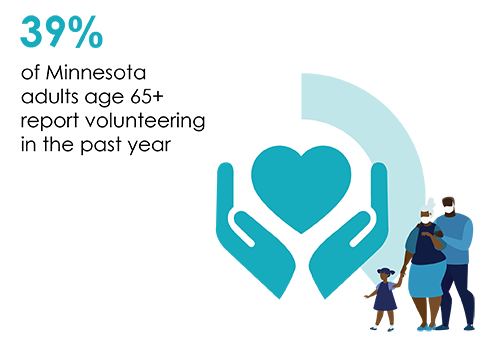May is Older Americans Month so we're taking this opportunity to take a closer look at Minnesota's older adult population.
1. Minnesota's older adult population is growing
There are currently almost 950,000 adults age 65 and older in Minnesota, making up almost 17% percent of the population. By 2038, that population is projected to top 1.26 million, and more than 1 out of every 5 Minnesotans will be an older adult.
In the next five years or so, Minnesota is also expected to reach the point where we have 1 older adult for every 3 adults of working age. A decade ago, that ratio was 1 for every 5. This huge demographic shift will continue to have a widespread impact on Minnesota’s economy, health care system, and social services.
2. Greater Minnesota is "greyer" than the Twin Cities
Most greater Minnesota counties have a larger share of older residents than the Twin Cities metro area counties have. For many rural counties, more than 1 in 4 residents is over age 65. Communities in greater Minnesota face unique challenges in meeting the needs of aging populations, including infrastructure maintenance, access to broadband, shifts in traditional industries, and stagnating or declining working-age populations.
3. Older adults are less racially and ethnically diverse than younger Minnesotans

Only about 7% of Minnesota seniors are people of color, compared to 21% of working-age people and 32% of children. Older Minnesotans are also less likely to be foreign-born than working-age adults (5% of seniors, vs. 11% of people ages 20-64).
4. Health care needs increase with age
Older adults are much more likely to have a health condition that makes it difficult to live independently without help. While about 1 in 14 Minnesotans under 65 have a disability, that figure rises to 1 in 5 for Minnesotans ages 65-74, 1 in 3 for those 75-84, and 2 in 3 for those 85 and older. Ensuring that our health care system can meet this growing need is one of the biggest challenges Minnesota faces as its population ages.
5. Most older adults live independently
 90% of older adults in Minnesota live independently in their own homes, with another 6% living with relatives or roommates, and 4% living in group facilities.
90% of older adults in Minnesota live independently in their own homes, with another 6% living with relatives or roommates, and 4% living in group facilities.
Among older adult heads of household in Minnesota, 3 in 4 own their homes. However, about a third of older adult-headed households are paying an unaffordable amount for housing. That includes about 1 in 5 older homeowners, and more than half of older adult renters.
6. Many older adults work beyond traditional retirement age
 Traditional retirement age is 65 years, but we know that many older adults continue working for years or decades after their 65th birthday. Today, more than a quarter of 65-74-year-olds are still in the workforce, along with 7% of adults 75 and older.
Traditional retirement age is 65 years, but we know that many older adults continue working for years or decades after their 65th birthday. Today, more than a quarter of 65-74-year-olds are still in the workforce, along with 7% of adults 75 and older.
Projections show that Minnesota will have 3.4 million jobs in 2030, but only about 2.8 million working-age adults employed. Older adults could help fill about 40% of the shortfall if current employment levels continue.
7. Older adults are engaged in their communities
 Minnesota adults age 65+ have one of the highest rates of volunteering in the nation. Minnesota’s older adults are also the most likely of any age group to vote, and 2 out of 3 Minnesotans age 65+ report helping or being helped by a neighbor in the past year.
Minnesota adults age 65+ have one of the highest rates of volunteering in the nation. Minnesota’s older adults are also the most likely of any age group to vote, and 2 out of 3 Minnesotans age 65+ report helping or being helped by a neighbor in the past year.
Minnesota’s aging population brings challenges for our state’s workforce, housing, and health care systems, but we start out with the advantages of an independent and civically engaged older adult community.
For more data on Minnesota’s older adults, see our profiles and key measures.
